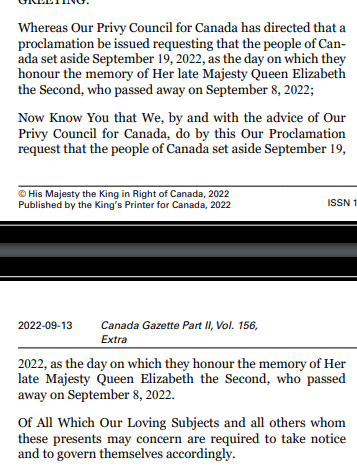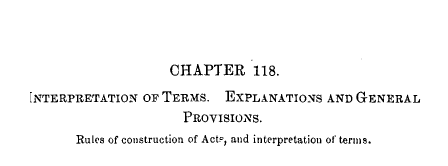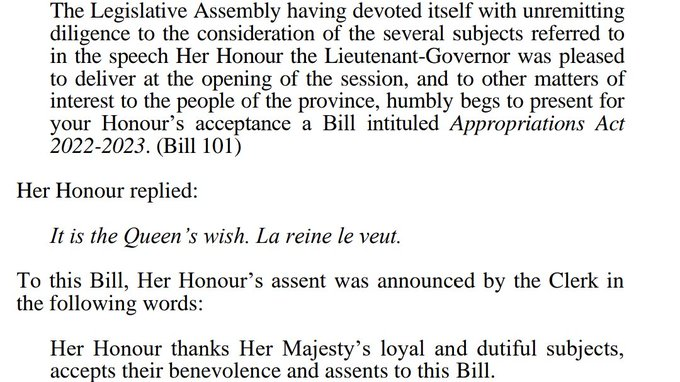Bill 104 - Public Health Act amendmendments: A brief discussion on suggested changes.
On May 10 the New Brunswick Government tabled Bill 104 which proposes to amend the public health act to provide clearer roles and responsibilities in the use of powers related to notifiable diseases like Covid-19. This legislation ensures that in the event of another wave of Covid-19 in the fall, the New Brunswick Government will have sufficient legislative tools to manage the pandemic without using the emergency measures act. New Brunswick was the last province to use its emergency legislation as the primary tool to respond to pandemics.
I discussed a series of needed changes in a prior blog post.I am pleased that the Government is reforming the act.
https://lyleskinner.blogspot.com/2022/04/suggested-changes-to-new-brunswick.html
For a general explanation of certain aspects of Bill 104, I refer you to a recent interview I gave with CBC Information Morning Fredericton.
https://www.cbc.ca/listen/live-radio/1-25-information-morning-fredericton/clip/15912105-changes-public-health-act
The following are a series of amendments and questions that should be asked in committee to provide clarity via legislative intent or through legislative amendments. The purpose for this is if these specific powers of the Public Health Act are used in the future, there is no confusion. Bill 104 is a substantive legislative improvement to the province’s pandemic response.
- Amend subsection 33.2(4)(c) to confer the power to only restrict non-essential travel between a health region. This would avoid a future order running into the same difficulties as the fall travel restrictions between health reasons. As I commented to CBC in Oct 2021, a draft order accidentally banned non essential travel in areas that did not require proof of vaccination where it would have been illegal to go to a grocery store but legal to go to a Casino as the latter required proof of vaccination. Modifying this subsection ensures that no order would restrict an individual's ability to attend medical appointments or other essential activities. Although there is a sufficiently large interpretation on what constitutes essential travel, it is preferable to provide a subjective consideration on a case by case basis. A strong policy reason for this is to ensure that an individual who is leaving their house in relation to domestic violence can also freely travel between a health region as this would obviously be an essential reason to travel.
Further there may be significant Charter considerations that would not be saved by S.1 related to S.7 “Life, Liberty and Security of the Person” if there is a prohibition on essential travel.
Amendment
33.2( 4) An order may provide for any action that the Minister considers necessary to prevent, decrease or eliminate the risk to health presented by the Group I notifiable disease, including
(a) directing the closure of a public place,
(b) restricting or prohibiting public gatherings in a health region,
(c) restricting non-essential travel to or from a health region, and
- Closure / Restriction Orders are too narrowly defined and do not include religious activities.
The bill grants the Chief Medical Officer of Health the authority to close or restrict the operations of certain premises, events and activities. This addresses a deficiency in the current act where there was no legal authority to close / restrict a premise preventively if there was not a notifiable disease.
The issue is whether the drafters intended to exempt religious activities or events from the powers of the Chief Medical Officer of Health.
Seek clarification and if needed a suggested amendment
Order respecting notifiable disease – premises, event or activity
33.1( 1) Subject to subsection (2), the chief medical officer of health may, by written order, require an owner or occupier of a premises or a person responsible for a recreational, sporting, religious or cultural activity or event to take or to refrain from taking any action that is specified in the order in respect of a notifiable disease.
Alternatively, simply deleting "recreational, sporting, or cultural" will enlarge the scope of application.
- Clarification on what constitutes an “other location” for the purposes of detention by a court or a medical officer of health for failure to follow an order of a medical officer of health. Possible amendment to ensure individuals detained at other locations are treated with “generally established medical practices”
It is my assumption that this is intended to provide alternative locations such as a facility similar to a quarantine hotel or another location to avoid using traditional hospital facilities to conserve primary medical resources. The intent of these orders are to “detain, examine or treat a person”. In essence there is an associated medical nexus where a person may be contagious with a Group I notifiable disease and detention is essential so that they can seek treatment and also prevent the infection of other people. The intent is not punitive. It is also not a mechanism to require an individual to quarantine at home if the province imposes a quarantine. That would occur via a Ministerial or Medical Officer of Health order.
New section 35.1 creates an agreement framework respecting the use of a location and also service standards but this is a separate consideration than ensuring reporting and treatment of specific individuals.
This gap is most notable in the proposed new court detention order under s.36(9) or emergency ex parte detention order under s.41(7)(b) and (ii) for example:
( ii) in the event that the person is detained in a hospital facility to care for the person and, when ordered, to examine and treat the person for the Group I notifiable disease in accordance with generally accepted medical practices
Effectively it is unclear why persons detained in other locations would not be examined and treated with generally accepted medical practices.
An example of suggested change, if warranted, so that everyone is treated in accordance with generally accepted medical practice.
Suggested Amendment: modify s.36(9)(b) to provide care with generally accepted medical practices regardless of location:
36( 9) (b) in the event that the person is detained in a hospital facility to care for the person and, when ordered, to examine and treat the person for the Group I notifiable disease in accordance with generally accepted medical practices.
Similar amendments would also need to occur in section 41( 7)(b) and 9(b)(ii):
41( 7)(b) in the event that the person is detained in a hospital facility to care for the person and, when ordered, to examine and treat the person for the Group I notifiable disease in accordance with generally accepted medical practices.
(d) by repealing paragraph (9)(b) and substituting the following:
( ii) in the event that the person is detained in a hospital facility to care for the person and, when ordered, to examine and treat the person for the Group I notifiable disease in accordance with generally accepted medical practices.
- Clarify medical supervision and reporting responsibilities for individuals supervising persons detained in “other locations”.
Section 37 requires an individual to be designated to be responsible for a detained person in hospital facilities. There is no one presently designated to have responsibility for individuals detained in “other locations”.
Suggested amendment
37(a) In the event a person who is delivered to a hospital facility operated by the regional health authority, the chief executive officer of a regional health authority, or a person designated by the chief executive officer, shall designate a medical practitioner or a nurse practitioner to have responsibility for the person named in an order made under section 36 and who is delivered to a hospital facility operated by the regional health authority.
(b) In the event of a person who is delivered to another location, the Minister shall designate an individual to have responsibility for the person named in an order under section 36
Similarly there is no reporting obligation for other locations to report to a Medical Officer of Health of the treatment and the condition of the detained person.
Suggested amendment
38 The medical practitioner, the nurse practitioner, or the person designated by the Minister, responsible for a person named in an order made under section 36 shall report in respect of the treatment and the condition of the person to the medical officer of health in the health region in which the hospital facility or other location is located and in the manner, at the times and with the information specified by the medical officer of health.
These changes to 37 and 38 would ensure that there is still a supervisory medical and reporting linkage for individual persons to an officer of health to ensure that they are receiving care. If there is a valid reason why there should not be these reporting and supervisory linkages, then government should provide clarity on this,
- Deficiency in issuing Class Orders for diseases that are not classified as a Group I notifiable disease. Grant power to the Chief Medical Officer of Health.
Presently Public Health views that Medical Officers of Health do not have the legal authority to issue class orders to groups of individuals. This creates an administrative inefficiency in the event of a larger but localized outbreak where all impacted individuals may not be known. Bill 104 proposes to grant the Minister of Health the power to issue class orders in relation to Group I notifiable diseases. This is appropriate given the additional powers granted to the Minister. However the Chief Medical Officer of Health should also be given the authority to issue class orders in relation to all notifiable diseases including Group I to address local or regional outbreaks that do not require Ministerial intervention. At minimum, there should be a clarification as to why there isn’t a power to issue a class order respecting a notifiable disease that isn’t classified as Group I. The Minister of Health should have additional powers to to restrict intraprovincal travel, public gatherings and places. Conferring an additional power to the Chief Medical Officer of Health to issue class orders for any notifiable disease would mirror similar legislative authorities found in other provinces such as PEI where there is the authority to issue a class order for any notifiable disease.
Suggested Question or Amendment
Clarification as to why neither the Minister nor the Chief Medical Officer of Health have the power to issue a class order for a notifiable disease that isn’t classified as Group I.
Depending on the view of the Assembly, it would be to either amend s.33.2 to provide the power to either the Minister of Health or the Chief Medical Officer of Health to issue class orders for any notifiable disease while reserving certain powers regarding closures of gatherings, public places and travel solely to the Minister of Health.
Alternatively, it would be to insert a new section 33.21 which would mirror 33.2 but confer a class order power related to notifiable diseases to the Chief Medical Officer of Health except for the 33.2(4)(a)(b)(c) Group I notifiable disease powers.
- Clarify that Class Orders and Orders related to Premises, Event or Activity are renewable.
Both Class Orders 33.2( 3) and Orders related to Premises, Event or Activities (33.1( 3)) are limited to a 14 day duration. However there is ambiguity on whether they can be renewed if there is a public health requirement to do so.
Amendment: I would recommend interesting a new subsections 33.2(3.1) & 33.1(3.1) to indicate that an order can be extended for an additional 14 day increments provided that the Minister or Chief Medical Officer of Health are satisfied that the criteria under 33.2(2) or 33.3(2) still exists to warrant an extension.
- Create an oversight function for the Legislative Assembly if either a Ministerial Class Order under s.33.2 or a Cabinet regulation issued pursuant to s.42(nn) is invoked.
A possible role would be for the Minister of Health to table in the Legislative Assembly within 14 days of a Ministerial or Cabinet Order a report pertaining to the effectiveness and necessity of the Order to prevent, decrease or eliminate the risk to health presented by the Group I notifiable disease. The report would be automatically deemed referred to the Standing Committee on Social Policy for review.
I am of mixed opinion whether there should be a role of the Assembly in terminating the extended use of a Ministerial class order or Cabinet order related to a notifiable disease. Although this may be an ideal role respecting oversight and some provinces have this provision, I am uncertain of its overall effectiveness. A preferable option would be for the Standing Committee on Social Policy to review a report issued by the Minister. This would facilitate an appropriate degree of legislative oversight if Ministerial intervention is required without monopolizing House time. The Committee would be able to meet on a more frequent basis including during the extended adjournment of the Assembly. A power either conferred in statute or by resolution of the Assembly to allow for the Committee to have intersessional authority in the event of prorogation would be advisable.
The purpose for including s.42(nn) is to account if Cabinet decides to make regulations related to the control of notifiable diseases similar to the COVID-19 Preventative Measures regulation.

























